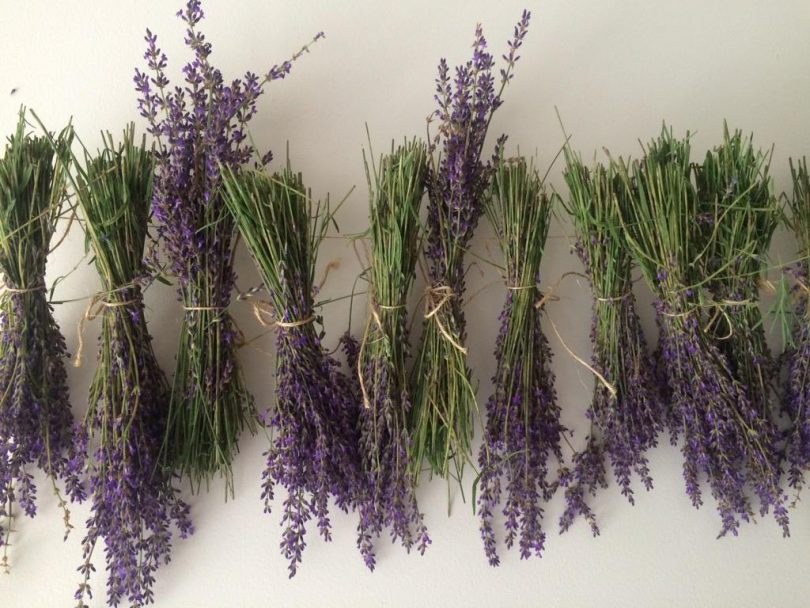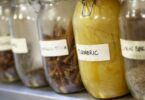Learn how to dry lavender leaves at home!
Here are the easiest D.I.Y methods of drying lavender leaves to keep them in arm’s reach whenever we would need them. This article will cover tried and tested methods for drying lavender leaves at home.
How to Dry Lavender Leaves at Home
Some tips before starting the drying process
Before we dive into the different methods of drying lavender leaves, here are some quick tips to ensure that you will be harvesting your lavender leaves right in preparation for drying.
- Harvest the lavender leaves while they are still green. The best period to do this is shortly after its flowers bloom.
- The most recommended time to harvest lavender leaves is in the late morning. This is the time of day when they are at its driest and yet their fragrance is at its peak.
- Ensure that your scissors or pruning shears are very sharp for ease of cutting without having to yank and risk hurting the plant.
- Cut leaves only from the tops of the plant. Cutting too far down the base of the plant may hurt it cause the plant to not grow back.
- Although all lavender variants may be dried, the most popular is the English lavender because it has the most potent oils and fragrance compared to the other kinds.
A bonus: Drying lavender leaves via microwave, oven, or food dehydrator will fill your house with its magnificent aroma!
Air drying lavender leaves
- Cut off the upper tips of the lavender plant where the stems are thinner.
- Remove the leaves from the stem and spread them loosely on a paper towel or kitchen towel. Let them air dry for several days in a dark and dry location.
- The more loosely the leaves are scattered, the faster they will dry.
Leaves must be checked daily to ensure they are drying well and not growing moldy.
Dry bunching lavender leaves
- Cut off lavender stems.
- Bunch the stems together in groups of 10 – 15 stalks. Tie them with elastic bands.
- Hang the bunches from a drying rack upside down in a dark, warm and dry room. Leaving them in a damp room may cause molds to grow on them.
- Allow for some spaces in between the stems to facilitate proper air drying.
Stems must be checked daily to ensure they are showing signs of drying rather than molding.
Drying lavender leaves with a dehydrator
- Inspect for any discolored or shrunken leaves from your harvest. Pick off all of these imperfections while also making sure there are no insects included in your bunch.
- Lay the stalks flat with ample spaces between them on the food dehydrator tray. Do not overlap.
- Put the dehydrator on herbal setting and leave for 2 hours.
- Check on the leaves. If they feel dry and papery to touch, they are done. If they still feel a bit moist, they should be put back in the dehydrator for another hour.
Once the leaves are done drying, take the tray out and let them completely cool off on top of a counter before storing.
Note: This method is safer against burning compared to using the microwave or oven.
Drying lavender leaves in the oven
- Preheat the oven to low heat at around 100 degrees Celsius or 200 degrees Fahrenheit.
- Set the harvested leaves on an ungreased sheet tray, evenly spaced.
- Pop the tray in the oven for 10 minutes. Keep the oven door ajar while drying to allow for moisture to escape.
- After 10 minutes, check if the leaves feel dry and brittle. If they still feel moist, flip the stems over and pop in the oven for another 5 minutes.
Once done, take out the sheet tray and allow to completely cool before storing.
Note: This method requires close monitoring due to the risk of burning if overly done.
READ ALSO: Drying Herbs in the Oven: Everything You Need to Know
Drying lavender leaves in the microwave
Drying lavender leaves in the microwave is something I don’t recommend, as there is a high risk of burning your leaves (and your microwave). But if you still want to try this method, here how you should do it.
- Remove the lavender leaves from the stem.
- Leaves may be placed directly on the turning tray of the microwave or over 2 layers of paper towels. Spread them in a single layer.
- Turn the microwave on high heat for one minute.
- Check if the leaves feel dry. If they still feel moist or fresh, they may be put back in the microwave for another 20 seconds.
- Closely monitor the leaves as they are drying for they may be prone to burning.
Allow to completely cool before storing.
READ ALSO: Drying Herbs in a Microwave – Preparation, Drying Process, and Storage
Proper Storage of Dried Lavender Leaves
Once the lavender leaves are done drying from any of the methods you may have chosen from above, storing is as easy as pie. Simply put the dried leaves inside a brown paper bag secured tightly shut, in a ziplock bag or inside a glass jar. Keep them in a dark cabinet, untouched by sunlight.
Another option is to keep them hanging in bunches from hangers inside a closet. They may also be put to use immediately by putting them inside scented sachets as natural air fresheners or display them as part of a dried flower arrangement.
Stored dried lavender leaves may be used or kept until there is still color or scent left in them. When properly dried and stored, lavender leaves may be kept in storage for up to a year.
READ ALSO: How to Store Dried Lavender
If you don’t want to throw away your dried leaves after they have lost their scent, they may also be refreshed by adding a few drops of lavender essential oil in the storage canister.
Depending on the equipment you have on hand and your patience in waiting for your leaves to dry, there is a drying method that is just right for you. They are all equally easy, too! Try drying your lavender leaves for an all-natural and all-around aid in a jar.





